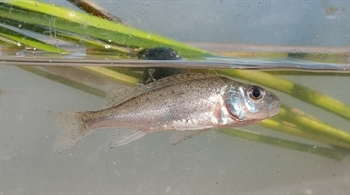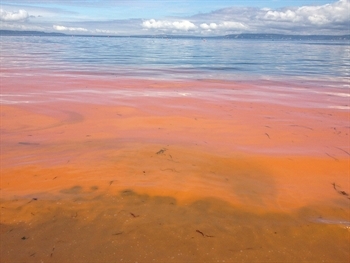This is the latest in the Separation Anxiety series, detailing Josh Ellis' reactions and reflections as an advisory committee member for the Great Lakes Commission and Great Lakes and St. Lawrence Cities Initiative's Restoring the Natural Divide: Separating the Great Lakes and Mississippi River Basins in the Chicago Area Waterway System. See the first, second, third, fourth, fifth and sixth installments to get caught up to speed.
Today is a day a lot of Great Lakes and Mississippi River interests have been waiting for for a long time: The U.S. Army Corps of Engineers released the Great Lakes and Mississippi River Interbasin Study, detailing cost assessments, risk thresholds and timelines for possible options to mitigate the spread of aqautic nuisance species (including, but not limited to, Asian carp). The summary is a very readable 25 pages, the full report is...fuller.
The Corps' charge in preparing this report was to provide "a range of options and technologies to prevent the transfer of aquatic nuisance species between the Great Lakes and Mississippi River basins through aquatic pathways," and that's what the report lays out, no more, no less. There are no recommendations. There are no suggestions as to which option is best. The Corps provides a range of structural (i.e. go build something) and non-structural (i.e. go do something, like commercial fishing) options, the timelines by which those invesment will eliminate the vast majority of risk of species transfer, the interventions needed to do so, and the costs. It will be up to Congress to determine what to do next.

The ruffe is an invasive species threatening the Mississippi River Basin from the Great Lakes Basin.
Photo by Flickr user Sergey Veliseev
And that will be no easy task. This is far more challenging than keeping fish from swimming up the Mississippi River, through the Chicago Area Waterways System (CAWS), and into Lake Michigan. First, there are several other organisms of concern, and many of them are actually moving from Lake Michigan toward the Mississippi River, which is the direction the water flows due to our region's reversal of the Chicago and Calumet rivers many moons ago. An interim carp-oriented solution at a dam somewhere on the lllinois River could theoretically prevent those fish from getting up over the dam or through the lock, but anything in the water falling over the dam is still going to find its way downstream. Second, all those organisms behave very differently (some are actually plants, not animals), which affects design and operations. The Corps' charge was to propose a range of solutions that would work to prevent transfer of all those nuisance species, not just a few of them.
The resulting set of alternatives are not overly surprising: The only real way to block the movement of aquatic species is to block aquatic movement, and that means a wall. A physical separation that impedes the flow of water. As the advisory committee member for the Great Lakes Commission and Great Lakes and St. Lawrence Cities Initiative's Restoring the Natural Divide: Separating the Great Lakes and Mississippi River Basins in the Chicago Area Waterway System project has learned over the years, where that wall (or walls) goes has very, very different ramifications for the flow of water and boats. Keep in mind that the CAWS is the main conduit for moving stormwater and treated effluent through the Chicago region, and is a thoroughfare for commerical and recreational boats. A wall is no small deal.
Given all that, the eyes of the broad Great Lakes region, from Buffalo, N.Y. to Toronto, Canada to Duluth, Minn., are still likely to rise when they see some of the cost estimates in the Corps report. The least expensive—$0—is the no action scenario, and is a non-starter. The only scenario that doesn't include building anything is the non-structural scenario, and at $68 million, still doesn't work to prevent movement of anything but grass kelp. And then the price jumps a bit, with the remainder of the scenarios coming at somewhere in between $7.8 billion and $18.4 billion, and generally speaking, it's toward the higher end where the Corps projects the level of reduction in risk level they were asked to examine. It also takes 25 to 50 years to get there.
So, what does this mean? Two things, and it's already being interpreted this way based on what I've seen in the press and via social media:
- It means that the only true solution—physical separation—to invasive species transfer between the basins will cost billions of dollars. But to many people, such as staunch supporters of physical separation like the Alliance for the Great Lakes, that expenditure is a justified investment in the service of protecting Lake Michigan and beyond. I see their point.
- It also means that the only way we can really make a difference here is if we spend billions of dollars, which won't happen fast enough to stop the du jour species, Asian carp, and even then there will still be a shadow of a glimmer of an iota of a chance that something could still get across. Life finds a way. That's the take of the Unlock our Jobs coalition. I see their point too.
All this comes down to goals and values. Are we trying to stop Asian carp? Then modify downstream dams and fast, because there is reason to believe they are getting through the ballyhooed electric barrier. Are we trying to stop all invasive species? Then that comes with a big price tag, and the question is whether the goods are worth buying.
I still don't know what I think. The purpose of the Restoring the Natural Divide project was always to investigate physical separation further, to understand likely ramifications, and to ensure that the Corps considered it fairly in the Interbasin Study work. Mission accomplished, as the Study report is basically all about different separation scenarios. However...Physical separation clearly isn't the solution to Asian carp, but interim modifications to dams to keep them from getting upstream don't do anything to prevent downstream passage and could easily delude lots of people into thinking the problem is solved. Physical separation can't happen overnight because we'd start flooding even more frequently than we already do. If the problem is aquatic movement of all invasive species, in both directions, then the Corps has clearly stated here that physcial separation is part of any real solution.

Red algae also poses a risk from the Great Lakes Basin to the Mississippi River Basin.
Photo by Jeri Cusimano for EcologyWA (Flickr)
I don't think the Chicago region has decided what problem it's trying to solve, and so we keep speaking past each other. I see it happening in our advisory committee meetings. Stop Asian carp or stop invasive species transfer. We need to pick one. The Corps was tasked with the latter. Restoring the Natural Divide was galvanized by the former, but then focused on the latter. But there remains a large contingent of folks, very justifiably, focused on the former, and sincerely interested in solving it. They're sold on being part of Asian carp solutions. The case for stopping all invasive species transfer has not been won, despite what some might think, and so selling a complicated set of walls with price tag in the billions will be a tall order. The benefits of protecting the Great Lakes and Mississippi River systems from current and future invasive species threats have not been quantified, communicated and bought by all the people focused on Asian carp.
So I don't know where we go—that's why the title "Separation Anxiety" made sense when I started this series, and why it makes more sense now. The public sessions on GLMRIS results will be interesting, and I plan to be at the Chicago event on Thursday, Jan. 9. The Restoring the Natural Divide team will reconvene on Wednesday, Jan. 29, and it remains to be seen how the thrust of that effort will change. Now that physical separation is clearly on the table, how does that group pivot? Not sure. And I'll continue to muse here as this evolves. It appears I might be writing this series for 50 years. But mark my words, this will come down to who can convince Congress that $7 billion or $18 billion or $68 million or $0 is what it's worth to solve this mess.